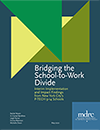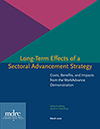Most Popular MDRC Publications of 2020

In 2020, MDRC published 100 reports, briefs, practitioner guides, blog posts, and infographics — offering evaluation results, profiles of innovative programs, and evidence-backed advice for policymakers and practitioners confronting both the crisis of the pandemic and longstanding inequities in society.
Here are the 15 most popular.
This report presents findings through three years from a replication of the City University of New York’s Accelerated Study in Associate Programs model at three community colleges in Ohio. The Ohio programs nearly doubled degree receipt through three years and led to an increase in transfers to four-year colleges.
 Conducting Virtual Focus Groups
Conducting Virtual Focus Groups
As the coronavirus pandemic unfolds, researchers are considering the implications of moving on-site data collection with program staff and participants to virtual settings. This post from the Implementation Research Incubator offers advice about switching from in-person focus groups to virtual focus groups.
This report evaluates a program focused on preparing students for college and career. Based on partnerships among high schools, community colleges, and employers, the program offers accelerated high school course work, early college, and work-based learning experiences. The findings suggest that students are meeting the benchmarks they need to succeed.
 Providing Emergency Aid to College Students in a Time of Crisis
Providing Emergency Aid to College Students in a Time of Crisis
The federal Coronavirus Aid, Relief, and Economic Security Act of 2020 has more than $6 billion in emergency aid for students. Research from MDRC and others points to several lessons that can help colleges distribute emergency aid promptly and equitably, and to the students who need it most.
In 2010, the U.S. Department of Health and Human Services and the U.S. Department of Labor launched complementary large-scale research projects on the effectiveness of the latest generation of subsidized employment models. This report summarizes findings from the studies and discusses the implications for practitioners, policymakers, and researchers.
![]() Getting Your Message Across with the Effective Communications Checklist
Getting Your Message Across with the Effective Communications Checklist
The COVID-19 pandemic has made written communication even more important. The checklist in this In Practice post incorporates principles of behavioral science to help organizations assess their current communications and get their point across more effectively.
 Shifting to Remote Service Delivery: Top Five Tips for Practitioners
Shifting to Remote Service Delivery: Top Five Tips for Practitioners
Here are MDRC’s Top Five Tips for social service and educational programs adapting to the COVID-19 pandemic. They focus on ensuring staff members’ and participants’ personal safety so that agencies can continue providing high-quality services and support while working remotely. They also include guidance on protecting participant confidentiality.
The surging unemployment rate brought on by the COVID-19 pandemic is likely to remain unusually high for many months. The findings from two large-scale studies suggest that public/nonprofit employers are much more likely to hire disadvantaged workers whose wages are subsidized than are private, for-profit employers.
 The Newly Virtual Workplace: Employers and Trainers Adapt
The Newly Virtual Workplace: Employers and Trainers Adapt
The COVID-19 pandemic has hit career and technical education programs especially hard. MDRC’s recent (virtual) discussion with representatives of 13 schools, districts, and programs that provide work-based learning found each of them seizing unexpected opportunities amid considerable challenges as they pivot from hands-on experiential learning to virtual instruction and work.
WorkAdvance goes beyond the previous generation of employment programs, concentrating on demand-driven skills training and identifiable career pathways. Findings show the approach increased earnings and led to advancement gains over time at the most successful study sites. One program, Per Scholas, boosted earnings by 20 percent in the last year of follow-up.
 COVID-19 and Rural Higher Education: Rapid Innovation and Ideas for the Future
COVID-19 and Rural Higher Education: Rapid Innovation and Ideas for the Future
The pandemic has exacerbated postsecondary education issues in rural areas that have affected students and communities for decades, such as the lack of adequate broadband infrastructure. In response, educators are developing innovative strategies that may be applicable to all institutions, not just those with a preponderance of rural students.
 Expanding the Earned Income Tax Credit as a Response to the COVID-19 Crisis
Expanding the Earned Income Tax Credit as a Response to the COVID-19 Crisis
The COVID-19 pandemic has heightened the nation’s awareness of the critical role that low-wage workers — cashiers, nursing assistants, delivery people — play in our lives. MDRC’s Cynthia Miller summarizes research about how expanding the Earned Income Tax Credit can effectively supplement their earnings and lead to other positive benefits for them and their families.
 Voices from the Field: How Community Colleges Are Advancing Equity in Career and Technical Education
Voices from the Field: How Community Colleges Are Advancing Equity in Career and Technical Education
Community college career and technical education (CTE) can fill shortages in the labor market while providing a pathway to economic mobility. But can it do so equitably? In 2019, MDRC’s Center for Effective CTE conducted a scan of notable programs across the country to find out more.
 The EASE Handbook for Community Colleges: Encouraging Additional Summer Enrollment
The EASE Handbook for Community Colleges: Encouraging Additional Summer Enrollment
The EASE project demonstrates that it is possible to increase enrollment in summer courses and help students earn more credits using an informational campaign that incorporates behavioral science principles and tuition-assistance grants. Use this handbook to customize and implement your own summer enrollment informational campaign.
 Conducting Home Visits Without Visiting Homes: How Child First Is Adapting to the COVID-19 Pandemic
Conducting Home Visits Without Visiting Homes: How Child First Is Adapting to the COVID-19 Pandemic
Home visiting programs like Child First are a vital support system for families coping with challenges such as homelessness, poverty, drug abuse, and maternal depression. As the COVID-19 crisis continues, Child First teams have transitioned to telehealth technology to maintain their relationships with families and provide them with much-needed services.






 Increasing Community College Graduation Rates with a Proven Model: Three-Year Results from the Accelerated Study in Associate Programs (ASAP) Ohio Demonstration
Increasing Community College Graduation Rates with a Proven Model: Three-Year Results from the Accelerated Study in Associate Programs (ASAP) Ohio Demonstration Bridging the School-to-Work Divide: Interim Implementation and Impact Findings from New York City’s P-TECH 9-14 Schools
Bridging the School-to-Work Divide: Interim Implementation and Impact Findings from New York City’s P-TECH 9-14 Schools Can Subsidized Employment Programs Help Disadvantaged Job Seekers? A Synthesis of Findings from Evaluations of 13 Programs
Can Subsidized Employment Programs Help Disadvantaged Job Seekers? A Synthesis of Findings from Evaluations of 13 Programs Ensuring Equity in Future Subsidized Employment Programs: The Critical Role of Nonprofits, Public Agencies, and Social Enterprises
Ensuring Equity in Future Subsidized Employment Programs: The Critical Role of Nonprofits, Public Agencies, and Social Enterprises Long-Term Effects of a Sectoral Advancement Strategy: Costs, Benefits, and Impacts from the WorkAdvance Demonstration
Long-Term Effects of a Sectoral Advancement Strategy: Costs, Benefits, and Impacts from the WorkAdvance Demonstration